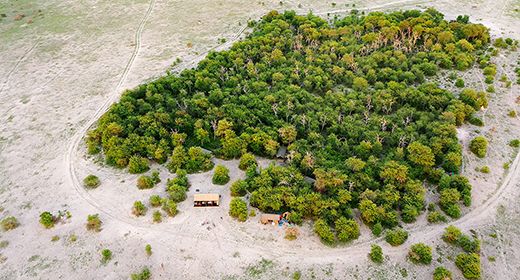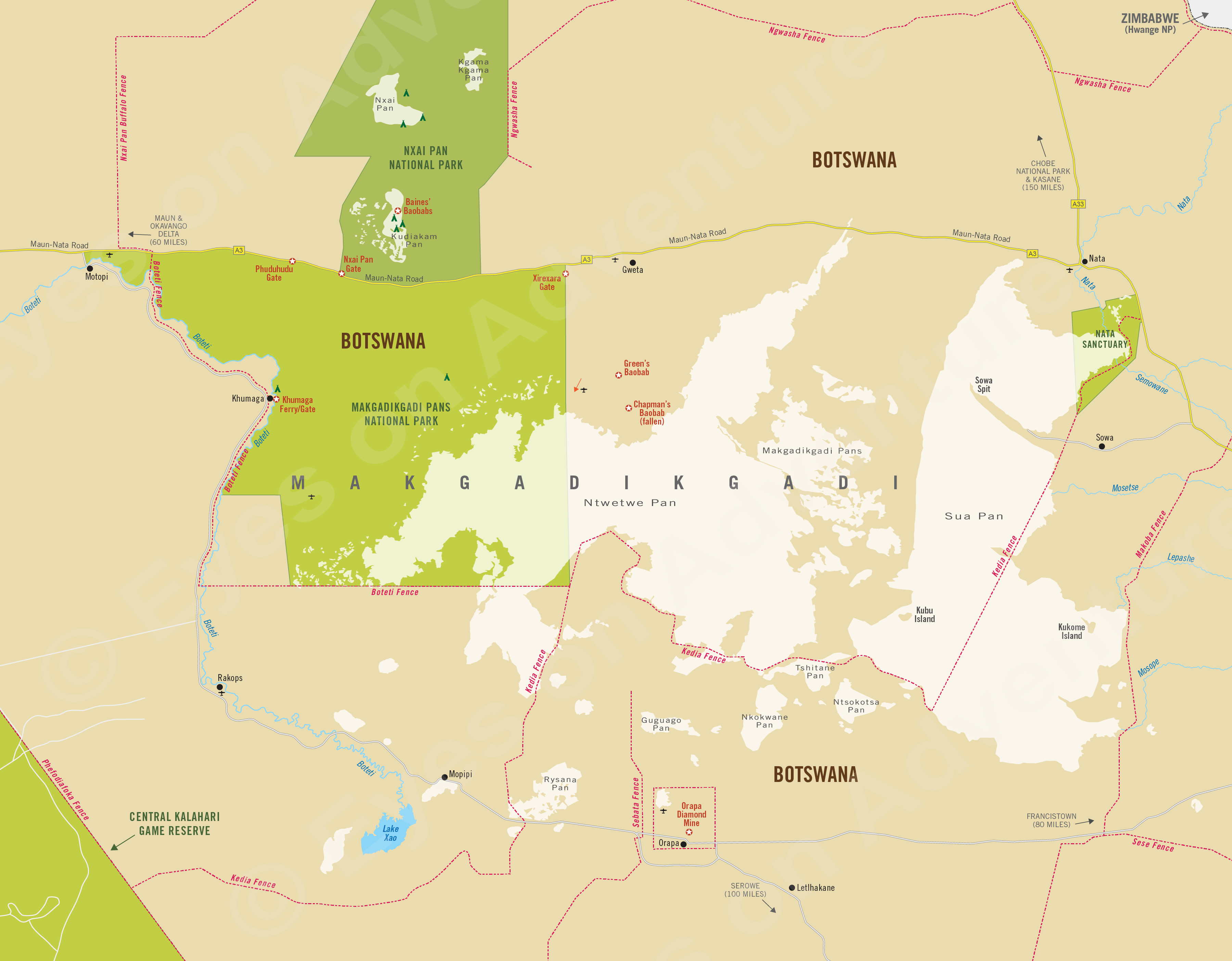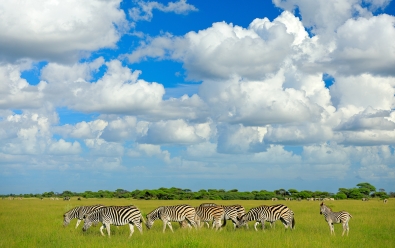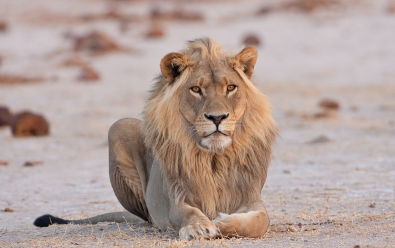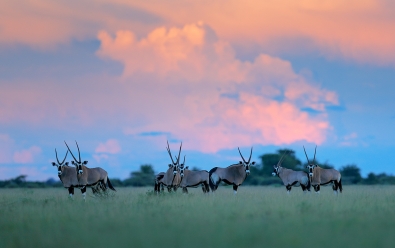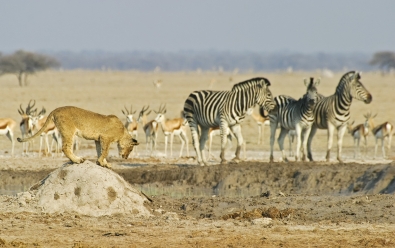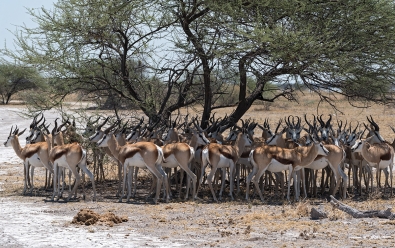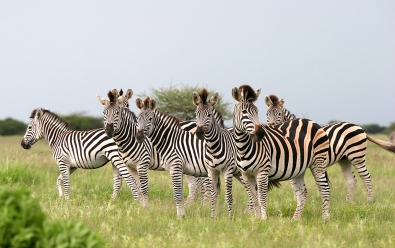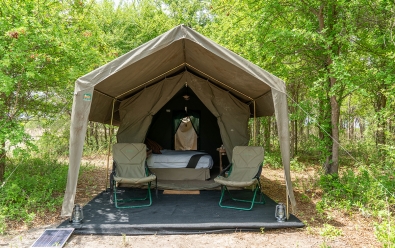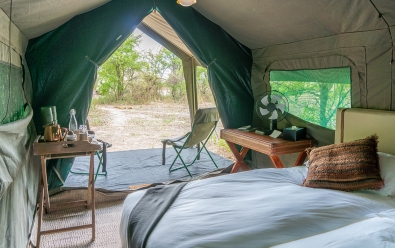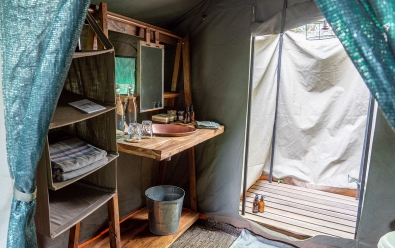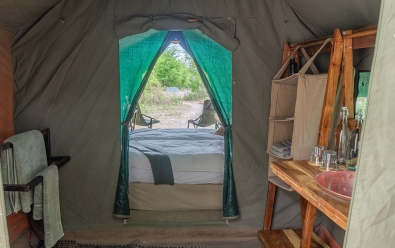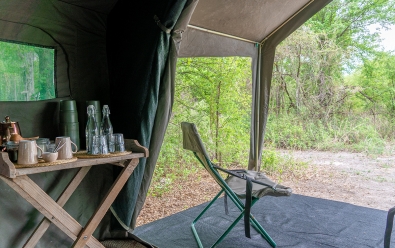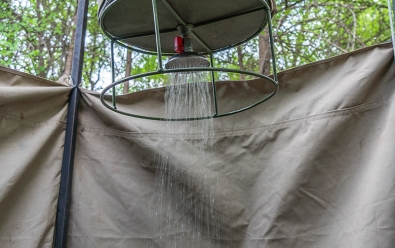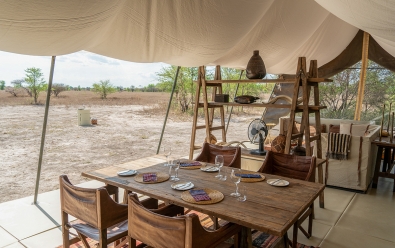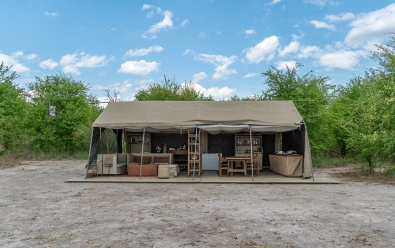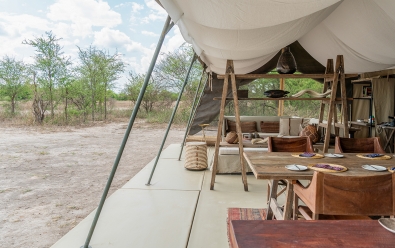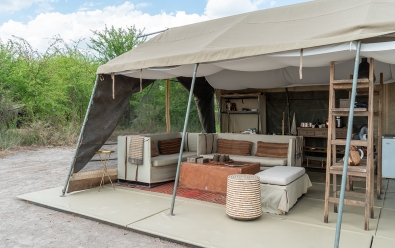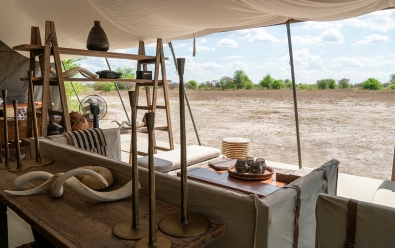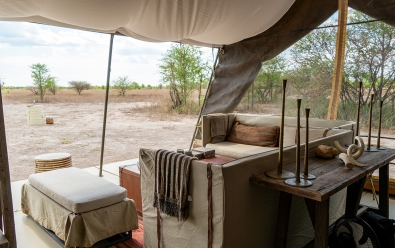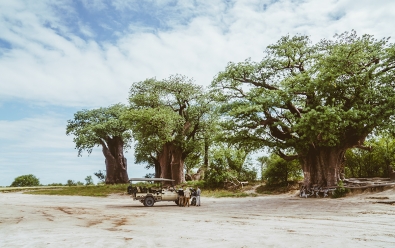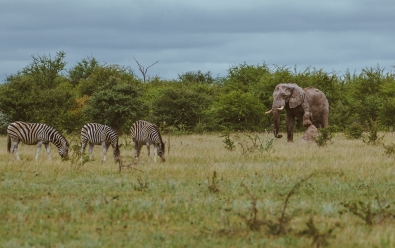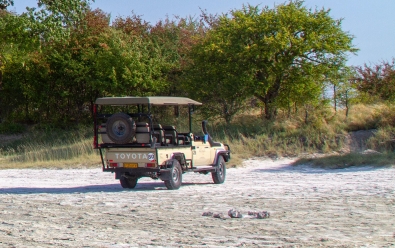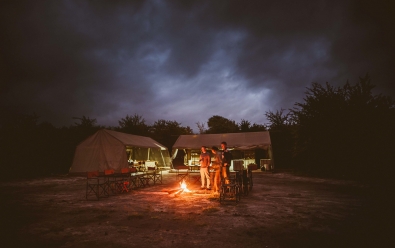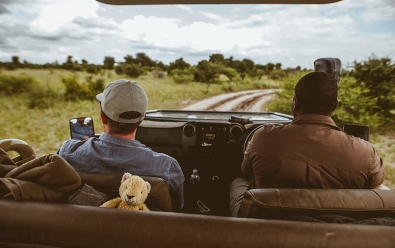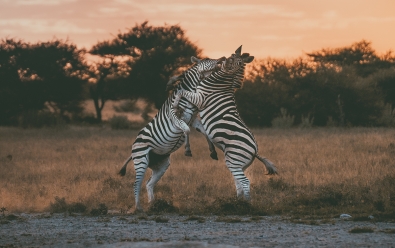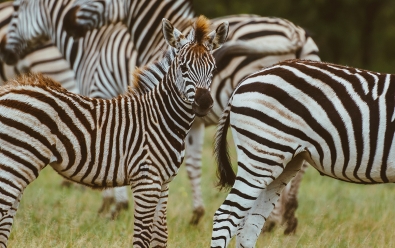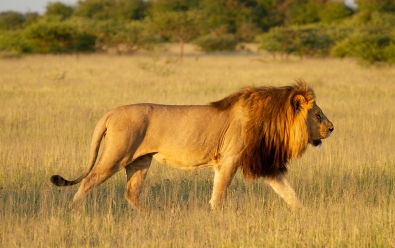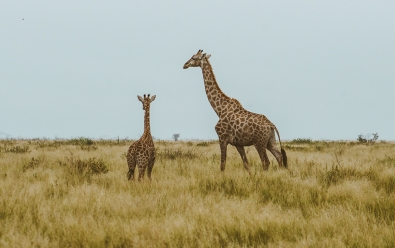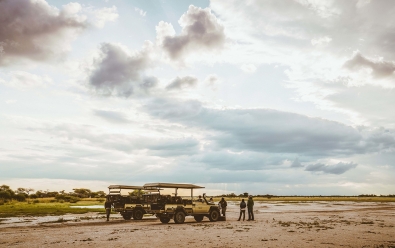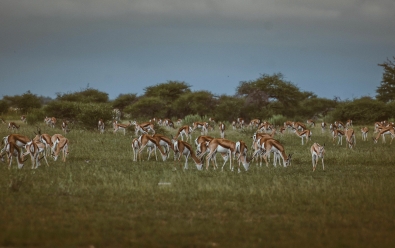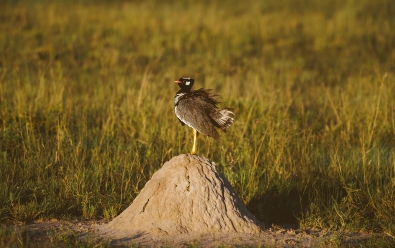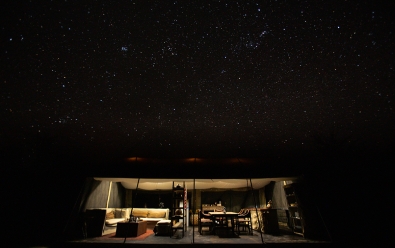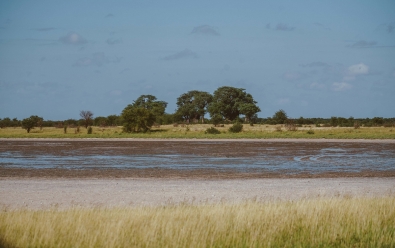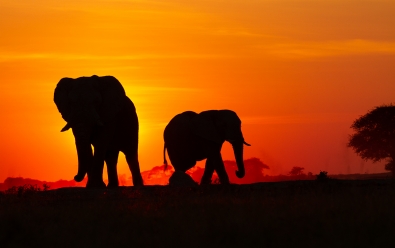Migration Expeditions Camp
Inquire for lodging prices
Highlights
- Small, seasonal, classic-style camp located in a remote wilderness.
- Game drives to see the diverse wildlife and vast salt pans.
- Experience the zebra migration.
- Visit the historic Baines' Baobab Trees.
Location
- Nxai Pan National Park
- Northeast Botswana
Migration Expeditions Camp is a small, seasonal camp like those of the early explorers, located in a remote wilderness and offering the zebra migration.
The camps is set at the edge of salt pan in Nxai Pan National Park, which is part of the greater Makgadikgadi Pans ecosystem.
During the rainy season months (December thru April), the area around the camp becomes a rich grassland that attracts large numbers of grazing herbivores, including zebras, which migrate to the area from wildlife areas to the north, including Chobe National Park and the Okavango Delta.
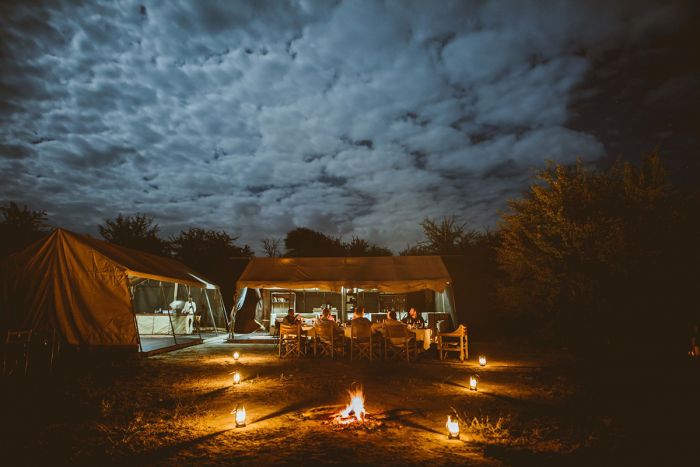
Around the campfire at Migration Expeditions Camp.
Besides the herds of zebra, the area around Nxai Pan attracts good numbers of blue wildebeest, springbok, impala, greater kudu, eland, red hartebeest, oryx, and giraffe. Predators seen regularly include lion, cheetah, African wild dog, and spotted hyena. Brown hyena are sometimes seen. Elephants also visit the area during the rainy months.
The remote and other-worldly feel of Nxai Pan National Park is perhaps its greatest attraction and guests will certainly not forget their experience here.
Activities at the camp include twice-daily game drives in open, 4x4 vehicles to see the wildlife and the amazing ecosystem. A half-day visit to see the historic Baines' Baobab trees, made famous by the British artist and explorer, Thomas Baines, who painted them in 1862 during an expedition with David Livingstone, is a must.
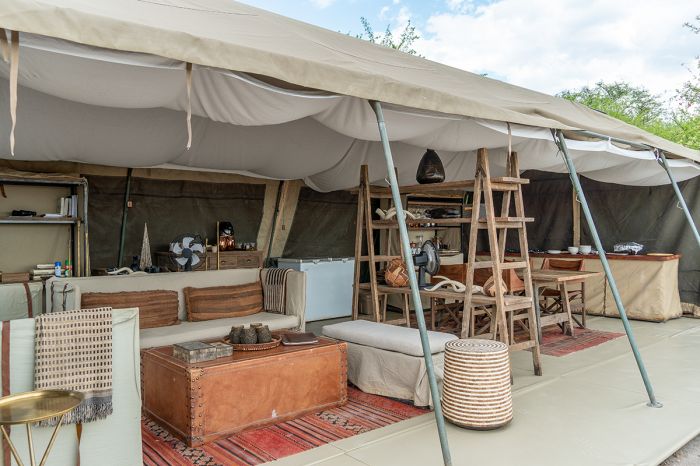
Main guest area lounge tent at Migration Expeditions Camp.
The camp has just four, Meru-style, safari tents that are simple and not over-the-top, but offer all needed creature comforts. The guest tents offer comfortable beds (twin or double setup) and en-suite facilities with a bucket-shower, wash basin, and chemical flush-toilet.
The main guest area includes two canvas-tented structure, one that is used for dining and features an open, interactive kitchen, and the other comprising a cozy lounge and bar. The main area's focal point is the campfire, which is ideal for evening drinks, snacks, and conversation about the day's adventures.
The camp operates primarily on solar energy, but a generator provides a backup power source and there is a charging station for electronics in the main guest area.
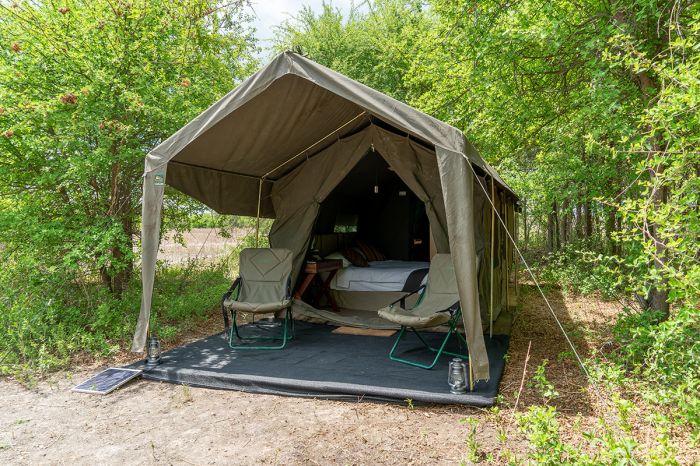
Guest tent at Migration Expeditions Camp.
Migration Expeditions Camp is owned and operated by African Bush Camps (ABC), a company founded by a professional African safari guide, who has a passion for protecting remote spaces and the wildlife that lives there.
African Bush Camps owns safari camps in Botswana, Zimbabwe, and Zambia. The ABC camps are fully sustainable, with minimal impact on the environment. The African Bush Camps Foundation runs local projects that empower the local communities wherever they operate safari camps. The company's aim is to conserve and preserve wildlife and natural areas in Southern Africa.
About Nxai Pan National Park
Nxai Pan National Park covers 1 026 square miles (2 658 sq kms) and is contiguous with the Makgadikgadi Pans NP to the south, separated by the Maun-Nata Road.
Nxai Pan and Kudiakam Pan are both a part of the ancient lake bed that formed Sua and Ntwetwe Pans, but due to its higher elevation, Nxai Pan is not covered in leached salts and supports more vegetation.
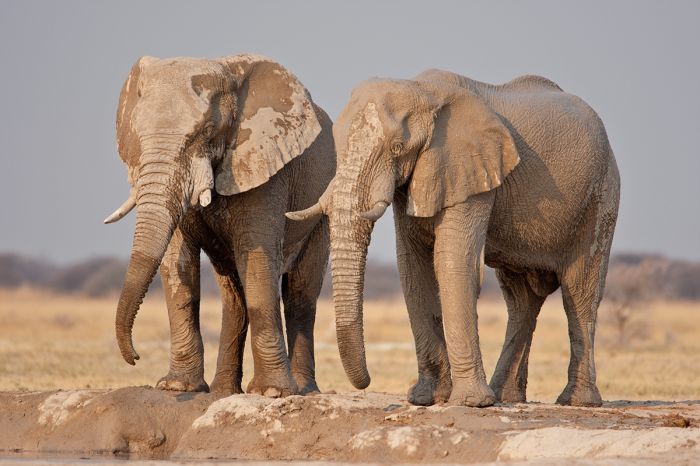
Bull elephants are sometimes seen around Nxai Pan.
The Nxai Pan region is dominated by open grassland and scattered Acacia tortilis trees and resembles the Serengeti region of northern Tanzania in many respects (but without all the tourists). The salt pans themselves are mostly covered with grass and surrounded by fossilized dunes of Kalahari sand.
There are numerous salt pans that fill with water during the rainy season and two pumped waterholes that are kept full in the dry season by the park authorities. The rivers that once filled the pans from the northeast have long since dried up.
During the rainy season months from December thru April, the lush, green grasslands around Nxai Pan become a haven and breeding ground for large numbers of zebras, blue wildebeests, and springbok. Also present are good numbers of red hartebeest, oryx, and eland.
Big herds of giraffe move through the grassy savannas to feed on the Acacia trees, while to the north of the pans, the mopane woodland supports browsing and cover for greater kudu and impala, which are often seen drinking and consuming salts at the waterholes. Tsessebe can also be seen on occasion; this being the southern extent of their Kalahari range.
During the verdant summer months, small breeding herds of elephant can be seen around Kgama Kgama Pan in the northeast of the park and lone bulls can be seen wandering through the mopane and at the waterholes. Bat-eared foxes are here in large numbers, as well as lion and spotted hyena that follow the grazers.
Most of the grazers disperse once the rains have ended (around May), with the exception of the hardy springboks, which remain in the area throughout the dry winter months. The springboks and open grasslands are perfect hunting grounds for cheetah and African wild dogs and both species are sighted here occasionally.
Baines' Baobabs
Originally known as the 'Sleeping Sisters', Baines' Baobabs are located on the edge of Kudiakam Pan in the southern section of the park. This cluster of baobab trees was famously painted by artist and adventurer Thomas Baines in 1862. Baines was a member of David Livingstone's expedition to the Zambezi.
The trees have changed very little in the years since Baines painted them, including the one tree lying on its side, which is still thriving.
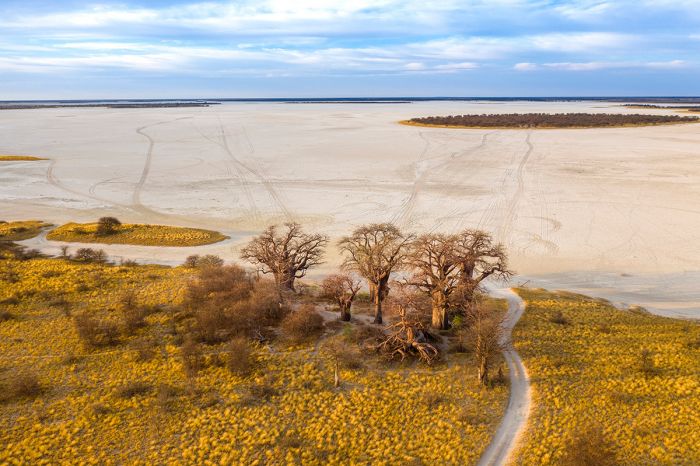
Baines' Baobabs in Nxai Pan National Park.
ROOMS INCLUDES & EXCLUDES CHILDREN FACILITIES ACTIVITIES
Accommodation
4 guest accommodations in total comprising:
- 4 twin-bedded, Meru-style, canvas tents, each with two three-quarter beds (convertible to a double bed). There is a small, covered veranda with chairs in the front of each tent.
All the tents feature en-suite facilities that include an open-air, enclosed bucket-shower, single-basin vanity, and a chemical flush-toilet.
The guest tents are set upon ground-level, wooden platforms with sand footpaths leading to the main camp area.
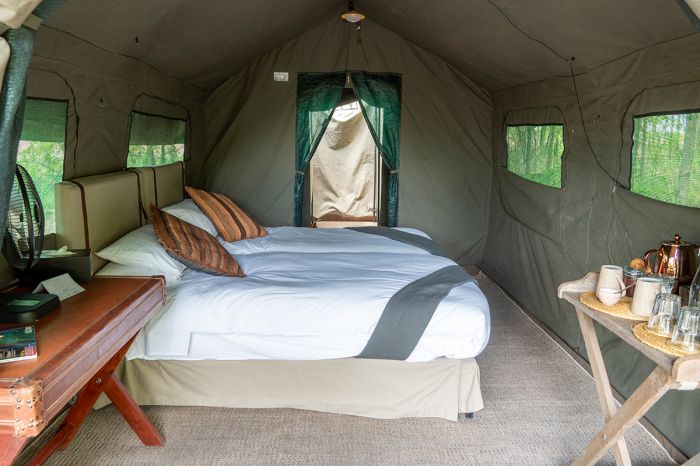
Guest tent interior at Migration Expeditions Camp.
Other items and features in the guest tents include:
- Outdoor veranda with seating.
- Writing desk and chair.
- Clothes and items storage shelves.
- Multi-plug charging station in the main camp area only.
- Personal amenities, including laundry basket, liquid soap, body wash, shampoo and conditioner, insect repellent, and insect spray.
Migration Expeditions Camp can accommodate a maximum of 8 guests in total: 2 guests in each of the guest tents.
Includes & Excludes
Includes:
- All meals and local beverages including wines, spirits and liqueurs, but excluding premium imported brands and Champagne.
- Twice-daily game drives in open game-viewing vehicles, nature walks, and half-day outings to visit Baines' Baobabs (all accompanied by experienced guides).
- Laundry services are provided on a daily basis (weather permitting, items will be returned on the same day). Laundry is dried by the sun and on most days any laundry placed out in the morning will be returned by the evening.
- Road transfers to/from Nxai Pan main gate.
- Tourism Levy & VAT.
Excludes:
- Premium imported beverages and Champagne.
- Any applicable wildlife fee, park fee, reserve fee, concession fee, other land-use fee.
Single Supplement
A single supplement will apply for any room booked by a single traveler; please ask us for pricing.
Children
Children 12 years and older are accommodated at Migration Expeditions Camp.
- Children aged 16 years and older will pay applicable adult rates and can be accommodated in a separate tent or sharing with a parent.
- Families with children will be accommodated in the same vehicle as other guests for game drives. Private vehicles are an option (subject to availability and at additional cost).
- All children must be supervised by their parents, as the camp is not fenced and is located in an area with wild animals.
Facilities
Migration Expeditions Camp is located in the wild and extremely remote Nxai Pan National Park and the camp is set within a small grove of trees on the southern edge of the salt pan for which the park is named.
During the rainy season months from December thru April, the lush, green grasslands around Nxai Pan become a haven and breeding grounds for large numbers of zebras, blue wildebeests, and springbok.
The main camp area consists of two canvas-tented structures supported by metal poles and set atop ground-level, wooden decking. One of the canvas hubs is for indoor dining and includes an open interactive kitchen, while the other is a cozy guest lounge that also includes the bar.
These two main tents open onto the campfire area on the ground.
Main guest area facilities include:
- Two canvas-tented hubs: one is a cozy lounge and bar, while the other is used for dining. Both are open to the front (with roll-down flaps in case of wind or rain) and constructed atop ground-level, wooden decking.
- Charging station for electronics.
- Campfire area.
Activities
Activities included in the rate:
- Twice-daily game drives in open, 4x4 Land Cruisers.
- Birding.
- Half-day visits to the historic Baines' Baobabs.
Example of a typical day:
- Early morning wake-up call. Morning wake-up and activity times vary according to the seasons, activities on offer, and wildlife sightings.
- Light breakfast before departing on the morning activity.
- Return to camp for a meal and rest period.
- Meet for afternoon tea and snacks (savory and sweet choices) before departing on the activity.
- Return to camp - freshen up or meet for drinks, followed by dinner.
- Enjoy a nightcap or discussion around the fire before retiring.
Great Good Fair Poor
- Jan
- Feb
- Mar
- Apr
- May
- Jun
- Jul
- Aug
- Sep
- Oct
- Nov
- Dec
When to Visit
The best wildlife viewing in the Nxai Pan area occurs during the wet season months from December thru April. The lush, green grasslands around Nxai Pan become a haven and breeding ground for large herds zebras, wildebeests, and springbok. Also present are good numbers of red hartebeest, oryx, and eland.
Migration Expeditions Camp is open seasonally from 01-December thru 31-March.
Wildlife Viewing
The large herds of blue wildebeest and Burchell's zebra migrate from the western side of the Makgadikgadi to take advantage of the sweet grasses at Nxai Pan. Springbok are also here in great numbers.
Lion and spotted hyenas are best seen during the rainy months when the big herds of herbivores have arrived. Small breeding herds of elephants also arrive for the fresh grazing and red hartebeest, eland and oryx are here as well. Bat-eared foxes are a specialty of the Nxai Pan region.
Cheetah and African wild dog are seen occasionally, preying on springbok and the impala. This is one of the few places one can see both springbok and impala together.
The Dry Season
The dry season in Nxai Pan is June through October.
This time of the year is generally far less productive for viewing wildlife than the wet season, with only the drought-tolerant springbok remaining here in big numbers.
The park authorities maintain several pumped waterholes and these provide some year-round water for the winter months. These waterholes can be extremely productive for game viewing during the dry season months.




